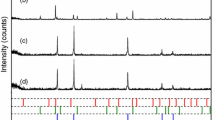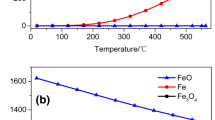Abstract
Thermodynamic analysis is used to assess the effects of various impurities in Fe and additives on the equilibrium phase composition of reaction products and heat generation in the Fe–C–NaCl–H2O–O2 system. It is shown that manganese impurity increases heat generation. Manganese, sulfur, and sulfur compounds decrease the equilibrium concentrations of gaseous species (H2, CH4, CO, H2O) forming during storage. Experimental results indicate that the gas evolution in the system can be reduced by pretreating the Fe powder with sulfur compounds, without significantly reducing the heat generation.
Similar content being viewed by others
REFERENCES
Drobot, N.F., Gavrichev, K.S., Noskova, O.A., et al, Effect of the Physicochemical Properties of Activated Carbon on the Heat Generation during Oxidation of Fe-Containing Mixtures, Zh. Fiz. Khim., 2001, vol.76, no. 1, pp. 95–98.
Drobot, N.F., Babievskaya, I.Z., Gavrichev, K.S., et al., Role of Activated Carbon in Chemical Interactions in the Fe-C-NaCl-H2O-O2 Heat-Generating System, Neorg. Mater., 2002, vol. 38, no. 5, pp. 610–615 [Inorg. Mater. (Engl. Transl.), vol. 38, no. 5, pp. 501-506].
Babievskaya, I.Z., Drobot, N.F., Gavrichev, K.S., et al., Phase Composition of the Products of Fe Oxidation in Fe + C + NaCl + H2O + O2 Exothermic Mixtures, Neorg. Mater., 2002, vol. 38, no. 6, pp. 711–722 [Inorg. Mater. (Engl. Transl.), vol. 38, no. 6, pp. 586-596].
Babievskaya, I.Z., Gavrichev, K.S., Drobot, N.F., et al., Controlled Oxidation of an Fe + C + NaCl + H2O Mixture: Phase Composition of Reaction Products and Dynamics of Heat Generation, Neorg. Mater., 2003, vol. 39, no. 7, pp. 822–826 [Inorg. Mater. (Engl. Transl.), vol. 39, no. 7, pp. 696-700].
Sinyarev, G.B., Vatolin, N.A., Trusov, B.G., and Moiseev, G.K., Primenenie EVM dlya termodinamicheskikh raschetov metallurgicheskikh protsessov (Computational Methods in the Thermodynamics of Metallurgical Processes), Moscow: Nauka, 1982.
Vatolin, N.A., Moiseev, G.K., and Trusov, B.G., Termodinamicheskoe modelirovanie v vysokotemperaturnykh neorganicheskikh sistemakh (Thermodynamic Modeling of High-Temperature Inorganic Systems), Moscow: Metallurgiya, 1994.
Yasuki, R. and Sawara, T., US Patent 4649895, 1987.
Khimicheskaya entsiklopediya (Chemical Encyclopedia), Knunyants, I.L., Ed., Moscow: Sovetskaya Entsiklopediya, 1990, vol. 2, pp. 480–482.
Ishii, M., Kitasumi, K., and Sawara, T., Jpn. Patent 58-037075, 1981.
Author information
Authors and Affiliations
Rights and permissions
About this article
Cite this article
Babievskaya, I.Z., Drobot, N.F., Shubina, A.E. et al. Influence of Impurities and Additives on the Phase Composition of Reaction Products and Heat Generation in the Fe–C–NaCl–H2O–O2 System. Inorganic Materials 40, 851–855 (2004). https://doi.org/10.1023/B:INMA.0000037932.61453.f8
Issue Date:
DOI: https://doi.org/10.1023/B:INMA.0000037932.61453.f8




